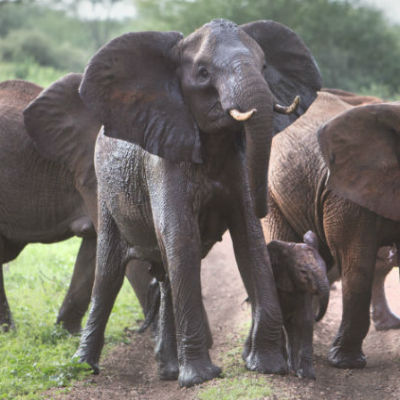Divided by dna. linked by loss
DIVIDED BY DNA. LINKED BY LOSS
Savannah and forest elephants diverged millions of years ago, but their plight is the same today, says Born Free’s Conservation Projects Officer Penny Banham
It may surprise you to learn that the African savannah elephant and the African forest elephant are wildly different, even though they evolved from a common ancestor two-and-a-half to five million years ago.
The forest elephant is physically smaller, with straighter, pinker tusks and lives in small groups. The savannah elephant is much larger, weighing almost double that of a forest elephant and lives in larger groups. Savannah elephants can be found in a variety of habitats, including open and closed savannah and arid deserts. Forest elephants primarily inhabit dense rainforest in the Congo basin, although they can be found in surprising places like oceanic beaches.
The biggest difference between them is how much we know about them. Living in open areas and in a number of relatively stable countries, the savannah elephant has been well studied by researchers for decades. However, the elusive forest elephant has received far less attention. Most of what we know about the forest elephant comes from studies of their dung. This knowledge deficit is dangerous; the plight of unseen animals that dwell deep in forests receives less attention and is harder for people to understand. Therefore, it does not garner much support.
Central and west Africa, home to the forest elephant, is a region characterised by conflict. Displaced people move into protected areas where forest elephants live, degrading and destroying habitat. The proliferation of automatic weapons and the opportunity to profit quickly from chaos turns some individuals into elephant poachers.
In more stable countries in this region, habitat is also being lost through development and investment – widespread land transformation by the extractive industries and agri-business and the informal sector, illegal mining and subsistence agriculture. This reduces forest cover, increases forest fragmentation and causes conflict between humans and elephants. All these factors mean that forest elephant populations are increasingly vulnerable to extinction. Between 2002 and 2011, the world’s forest elephant population fell by 62% and at least 12 elephant populations were reportedly lost across the region – in Côte d’Ivoire, Ghana, Guinea, Guinea Bissau, Nigeria, Sierra Leone and Togo. This decline is ongoing.

Whilst human elephant conflict and habitat loss also threaten the savannah elephant, poaching poses the greatest concern. Living across southern, eastern and northern Africa, the status of the savannah elephant is messy. Botswana, South Africa, Zambia, and Zimbabwe have relatively large elephant populations, which are actually increasing in some protected areas. This contrasts with Tanzania, a supposed savannah elephant haven, where 60% of the population has been lost to poaching since 2009. Nicknamed ‘the elephant killing fields’, poaching in the Ruaha-Rungwa ecosystem in southern Tanzania resulted in a shocking decline in elephant numbers, from 31,000 in 2009, to 8,000 in 2014.
We now know more than ever about elephant poaching and new evidence has profound implications for both savannah and forest elephants. Two poaching hotspots exist in Africa – one across Gabon and the Congo, home to the forest elephant, and the other in Tanzania, home to the savannah elephant.
The politics surrounding poaching has implications for elephants at the most basic genetic level. Despite insurmountable evidence, the International Union for Conservation of Nature and the Convention on International Trade in Endangered Species only recognises one species of African elephant which is listed on Appendix I. This means no trade is allowed with the exception of Namibia, Zimbabwe, South Africa and Botswana whose populations are listed on Appendix II, in which trade is controlled to prevent their extinction.
It is argued that if the two species were to be recognised separately, conservation strategies could be more successfully targeted for each species needs. However, there are serious concerns that due to the buoyant populations in southern Africa, the savannah elephant could be downgraded to a lower conservation status, allowing the legal trade of ivory (which in turn exacerbates the illegal trade). Forest elephants would be upgraded to a ‘critically endangered’ status, further polarising conservation efforts across the continent.
What is the solution? If the forest and savannah elephant were recognised as genetically distinct, listing all species of elephant on Appendix I regardless of diverse population trends would secure their protection. Even though some countries are less affected by poaching now, this could change rapidly. Poaching syndicates working in west, central and eastern Africa could turn their attentions to southern Africa very soon, as populations dwindle elsewhere. In fact, 87 elephants were slaughtered in August for their tusks close to an elephant sanctuary in Botswana.
Regardless of politics, the science is clear, elephants are gravely threatened. There are around 400,000 elephants left in Africa, of which 40,000 are being killed for the illegal ivory trade every single year. The savannah and forest elephants may have diverged millions of years ago, but their plight is the same today.

